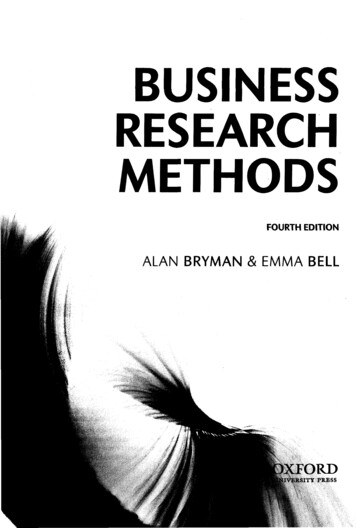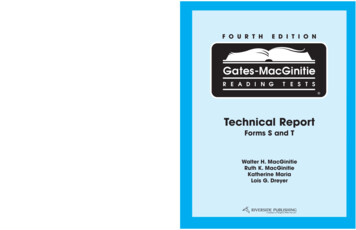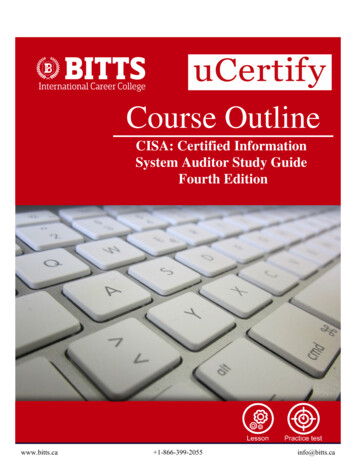
Transcription
BUSINESSRESEARCHMETHODSFOURTH EDITIONALAN BRYMAN & EMMA BELL
AbbreviationsAbout the authorsAbout the students and SupervisorsGuided tour of textbook featuresGuided tour of the Online Resource CentreAbout the bookAcknowledgementsChapter 1Chapter 2The nature and process of business nWhat is meant by 'business research'?Why do business research?Business research methods in contextRelevance to practiceThe process of business researchLiterature reviewConcepts and theoriesResearch questionsSamplingData collectionData analysisWriting upThe messiness of business researchKey pointsQuestions for review455579991012121313151616Business research Strategie:18Introduction: the nature of business researchTheory and researchWhat type of theory?Deductive and inductive theoryEpistemological considerationsA natural science epistemology: positivismInterpretivismOntological gy and ontology in business researchCompeting paradigms192020232627283232323435
Detailed ContentsChapter 3Chapter 4Chapter 5rResearch strategy: quantitative and qualitativeInfluences and politics on the conduct of business researchValuesPractica! considerationsKey poirttsQuestions for review373940424545Research designs47IntroductionQuality criteria in business researchReliabilityReplicationValidityResearch designsExperimental designCross-sectional designLongitudinal design(s)Gase study designComparative designLevel of analysisBringing research strategy and research design togetherKey pointsQuestions for review484949505053536166677275767878Flanning a research project and formulatingresearch questions80IntroductionGelting to know what is expected of you by your InstitutionThinking about your research areaUsing your SupervisorManaging time and resourcesFormulating suitable research questionsCriteria for evaluating research questionsWriting your research proposalPreparing for your researchDöing your research and analysing your resultsChecklistKey pointsQuestions for review81818283858793949495979898Gelting started: reviewing the literature99IntroductionReviewing the existing literature and engaging withwhat others have writtenGelting the most from your readingSystematic reviewNarrative reviewSearching the existing literature and looking forbusiness InformationElectronic databasesKeywords and defining search parameters100100103104110111112116
Detailed ContentsChapter 6Chapter 7Referencing your workThe role of the bibliographyAvoiding plagiarismChecklistKey pointsQuestions for review118122123125126126Ethics and politics in business research128IntroductionEthical principlesHarm to participantsLack of informed consentInvasion ofprivacyDeceptionEthics and legal considerationsData managementCopyrightReciprocity and trustAffiliation and conflicts of interestThe difficulties of ethical decision-makingThe politics of business researchChecklistKey pointsQuestions for 5155The nature of quantitative research159IntroductionThe main steps in quantitative researchConcepts and their measurementWhat is a concept?Why measure?IndicatorsUsing multiple-indicator measuresDimensions of conceptsReliabilityStabilityInternal reliabilityInter-rater reliabilityValidityFace validityConcurrent validityPredictive validityConstruct validityConvergent validityDiscriminant validityReflections on reliability and validityThe main preoccupations of quantitative IX
Detailed ContentsChapter 8Chapter 9GeneralizationReplicationThe critique of quantitative researchCriticisms of quantitative researchIs it always like this?Reverse operationismReliability and validity testingSamplingKey pointsQuestions for review174176178179180180181181181182Sampling in quantitative research183IntroductionIntroduction to samplingSampling errorTypes of probability sampleSimple random sampleSystematic sampleStratified random samplingMulti-stage Cluster samplingThe qualities of a probability sampleSample sizeAbsolute and relative sample sizeTime and costNon-responseHeterogeneity of the populationKind of analysisTypes of non-probability samplingConvenience samplingQuota samplingLimits to generalizationError in survey researchKey pointsQuestions for 0200200202205206207207Structured interviewing209IntroductionThe structured interviewReducing error due to Interviewer variabilityAccuracy and ease of data processingOther types of interviewInterview contextsMore than one intervieweeMore than one InterviewerIn person or by telephone?Computer-assisted interviewingConducting InterviewsKnow the scheduleIntroducing the researchRapportAsking 9219
Detailed contentsRecording answersClear InstructionsQuestion orderProbingPromptingLeaving the interviewTraining and supervisionOther approaches to structured interviewingCritical incident methodProjective methods, pictorial and photo-elicitationVerbal protocol approachRepertory grid techniqueProblems with structured interviewingCharacteristics of InterviewersResponse setsThe problem of meaningThe feminist critiqueKey pointsQuestions for reviewChapter 10 Self-completion questionnairesIntroductionSelf-completion questionnaire or postal questionnaire?Evaluating the self-completion questionnaire in relationto the structured interviewAdvantages of the self-completion questionnaire overthe structured interviewDisadvantages of the self-completion questionnairein comparison to the structured interviewSteps to improve response rates to postal questionnairesDesigning the self-completion questionnaireDo not cramp the presentationClear presentationVertical or horizontal closed answers?Identifying response sets in a Likert scaleClear Instructions about how to respondKeep question and answers togetherDiaries as a form of self-completion questionnaireAdvantages and disadvantages of the diary as amethod of data collectionExperience and event samplingKey pointsQuestions for reviewChapter 11 Asking questionsIntroductionOpen or closed questions?Open questionsClosed questionsTypes of questionRules for designing 46248248248251251254254256257257257259262264XI
XIiDetailed contentsGeneral rules of thumbSpecific rules when designing questionsVignette questionsPiloting and pre-testing questionsUsing existing questionsChecklistKey pointsQuestions for reviewChapter 12 Structured ObservationIntroductionProblems with survey research on behaviourSo why not observe behaviour?The Observation scheduleStrategies for observing behaviourSamplingSampling peopleSampling in terms of timeFurther sampling considerationsIssues of reliability and validityReliabilityValidityOther forms of structured ObservationField StimulationOrganizational SimulationCriticisms of structured ObservationOn the other hand.ChecklistKey pointsQuestions for reviewChapter 13 Content analysisIntroductionWhat are the research questions?Selecting a sampleSampling mediaSampling datesWhat is to be counted?Significant actorsWordsSubjects and themesDispositionsImagesCodingCoding scheduleCoding manualPotential pitfalls in devising coding schemesAdvantages of content analysisDisadvantages of content analysisChecklistKey pointsQuestions for 316317
Detailed contentsChapter 14 Secondary analysis and official statisticsIntroductionOther researchers' dataAdvantages of secondary analysisLimitations of secondary analysisAccessing the UK Data ArchiveArchival proxies and meta-analysisOfficial statisticsReliability and validityCondemning and resurrecting official statisticsOfficial statistics as a form of unobtrusive measureKey pointsQuestions for reviewChapter 15 Quantitative data analysisIntroductionA small research projectMissing dataTypes of variableUnivariate analysisFrequency tablesDiagramsMeasures of central tendencyMeasures of dispersionBivariate analysisRelationships not causalityContingency tablesPearson's rSpearman's rhoPhi and Cramer's VComparing means and etaMultivariate analysisCould the relationship be spurious?Could there be an intervening variable?Could a third variable moderate the relationship?Statistical significanceThe chi-square testCorrelation and Statistical significanceComparing means and Statistical significanceChecklistKey pointsQuestions for reviewChapter 16 Using IBM SPSS statisticsIntroductionGetting started in SPSSBeginning SPSSEntering data in the Data ViewerDefining variables: variable names, missing values,variable labels, and value labelsRecoding variablesComputing a new 69372XII
XIVDetailed ContentsData analysis with SPSSGenerating a frequency tableGenerating a bar chartGenerating a pie ChartGenerating a histogramGenerating the arithmetic mean, median,Standard deviation, ränge, and boxplotsGenerating a contingency table, chi-square, and Cramer's VGenerating Pearson's r and Spearman's rhoGenerating scatter diagramsComparing means and etaGenerating a contingency table with three variablesFurther Operations in SPSSSaving your dataRetrieving your dataPrinting OutputKey pointsQuestions for reviewChapter 17 The nature of qualitative researchIntroductionThe main steps in qualitative researchTheory and researchConcepts in qualitative researchReliability and validity in qualitative researchAdapting reliability and validity for qualitative researchAlternative criteria for evaluating qualitative researchThe main preoccupations of qualitative researchersSeeing through the eyes of the people being studiedDescription and the emphasis on contextEmphasis on processFlexibility and limited structureConcepts and theory grounded in dataNot just wordsThe critique of qualitative researchQualitative research is too subjectiveDifficult to replicateProblems of generalizationLackoftransparencyIs it always like this?Some contrasts between quantitative and qualitative researchSome similarities between quantitative and qualitative researchResearcher-subject relationshipsAction researchFeminism and qualitative researchCollaborative and participatory researchPostcolonial and indigenous researchKey pointsQuestions for 09413413414414414415416417418418420422422424425
Detailed contentsChapter 18 Sampling in qualitative researchIntroductionLevels of samplingPurposive samplingTheoretical samplingGeneric purposive samplingSnowball samplingSample sizeNot just peopleUsing more than one sampling approachKey pointsQuestions for reviewChapter 19 Ethnography and participant ObservationIntroductionOrganizational ethnographyGlobal and multi Site ethnographyAccessOvert versus covert?Ongoing accessKey informantsRoles for ethnographersActive or passive?ShadowingField notesTypes of field notesBringing ethnographic fieldwork to an endFeminist and institutional ethnographyVisual ethnographyWriting ethnographyExperiential authorityTypical formsKey pointsQuestions for reviewChapter 20 Interviewing in qualitative researchIntroductionDifferences between the structured interviewand the qualitative interviewAsking questions in the qualitative interviewPreparing an interview guideKinds of questionsUsing an interview guide: an exampleRecording and transcriptionTelephone interviewingLife history and oral history InterviewsFeminist research and interviewing in qualitative researchQualitative interviewing versus participant ObservationAdvantages of participant Observation in comparisonto qualitative XV
XVIDetailed Contents—iAdvantages of qualitative interviewing in comparisonto participant ObservationOverviewChecklistKey pointsQuestions for reviewChapter 21 FocusgroupsIntroductionUses of focus groupsConducting focus groupsRecording and transcriptionHow many groups?Size of groupsLevel of moderator involvementSelecting participantsAsking questionsBeginning and finishingGroup interaction in focus group sessionsThe focus group as a feminist methodLimitations of focus groupsChecklistKey pointsQuestions for reviewChapter 22 Language in qualitative researchIntroductionFine-grained approachesConversation analysisDiscourse analysisNarrative analysisRhetorical analysisContext-sensitive approachesCritical discourse analysisOverviewKey pointsQuestions for reviewChapter 23 Documenta as sources of dataIntroductionPersonal documentsPublic documentsOrganizational documentsMass media OutputsVisual documentsVirtual documentsThe world as textThe reality of documentsInterpreting documentsQualitative content 69569570
Historical analysisChecklistKey pointsQuestions for reviewChapter 24 Qualitative data analysisIntroductionGeneral strategies of qualitative data analysisAnalytic inductionGrounded theoryMore on codingSteps and considerations in codingTurning data into fragmentsProblems with codingThematic analysisSecondary analysis of qualitative dataKey pointsQuestions for 1604604Chapter 25 Computer-assisted qualitative data analysis: using NVivo 605IntroductionIs CAQDAS like quantitative data analysis Software?No industry leaderLack of universal agreement about the Utility of CAQDASLearning NVivoCodingSearching textMemosSaving an NVivo projectOpening an existing NVivo projectFinal thoughtsKey pointsQuestions for reviewChapter 26 Breaking down the quantitative/qualitative divideIntroductionThe natural science model and qualitative researchQuantitative research and interpretivismQuantitative research and constructionismEpistemological and ontological considerationsProblems with the quantitative/qualitative contrastBehaviour versus meaningTheory tested in research versus emergent from dataNumbers versus wordsArtificial versus naturalReciprocal analysisQualitative analysis of quantitative dataQuantitative analysis of qualitative dataQuantification in qualitative 626627629630631631631632633633635635635636
XViliDetailed ContentsJThematic analysisQuasi-quantification in qualitative researchCombating anecdotalism through limited quantificationKey pointsQuestions for reviewChapter 27 Mixed methods research: combining quantitativeand qualitative researchIntroductionThe argument against mixed methods researchThe embedded methods argumentThe paradigm argumentTwo versions of the debate about quantitative andqualitative researchThe rise of mixed methods researchClassifying mixed methods research in terms of priorityand sequenceDifferent types of mixed methods designApproaches to mixed methods researchThe logic of triangulationQualitative research facilitates quantitative researchQuantitative research facilitates qualitative researchFilling in the gapsStatic and processual featuresResearch issues and participants' perspectivesThe problem of generalityQualitative research may facilitate the Interpretation ofthe relationship between variablesStudying different aspects of a phenomenonSolving a puzzleQuality issues in mixed methods researchKey pointsQuestions for reviewChapter 28 E-research: Internet research methodsIntroductionThe Internet as object of analysisUsing Websites to collect data from individualsVirtual ethnographyQualitative research using online focus groupsQualitative research using online personal InterviewsUsing SkypeOnline social surveysEmail surveysWeb surveysMixed modes of survey administrationSampling issuesOverviewEthical considerations in e-researchThe State of e-researchKey pointsQuestions for 65667670673675675676676678679685685689689689
Detailed contentsChapter 29 Writing up business researchIntroductionWriting up your researchStart earlyBe persuasiveGet feedbackAvoid sexist, racist, and disablist languageStructure your writingWriting up quantitative, qualitative, and mixed methods researchAn example of quantitative researchIntroductionTheory and hypothesesMethodsResultsDiscussionLessonsAn example of qualitative researchIntroductionReview of the literatureMethodsPresentation of main themesDiscussionImplicationsLessonsAn example of mixed methods researchIntroductionThe Russian contextOrganizational culture and effectivenessResearch questionsTesting the model: a comparative studyTaking a closer look: four case studiesDiscussionLessonsReflexivityWriting academicallyChecklistKey pointsQuestions for reviewGlossaryReferencesIndex of namesSubject 3714714715718719720721731758764XIX
Chapter 20 Interviewing in qualitative research 478 Introduction 479 Differences between the structured interview and the qualitative interview 480 . 481 Preparing an interview guide 486 Kinds of questions 490 Using an interview guide: an example 492 Recording and transcription 494 Telephone interviewing 497 Life history and oral history .











